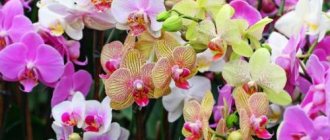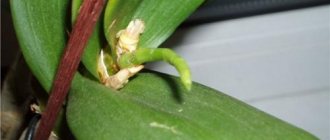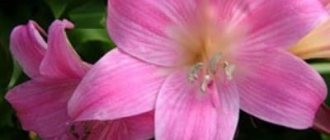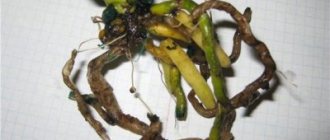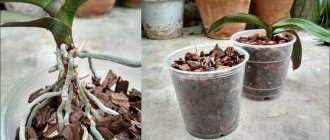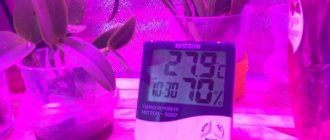The orchid does not grow or bloom, what should I do to make it bloom? When development stopped
If the orchid has stopped blooming, does not form flower arrows and does not produce leaves, you need to analyze the conditions in which the plant is kept. Sometimes it is enough to change watering, add lighting or bring the temperature back to normal and the problem of lack of flowering is quickly solved.
Substrate
In order for an orchid to bloom, it is important to grow it only on suitable soil. Regular soil is not suitable for this flower. It absorbs a lot of liquid and contains high concentrations of minerals. Also, a substrate based on sphagnum moss is not suitable for cultivating orchids. It has a high moisture capacity and can cause rotting of the root system.
Important!
If the soil is not selected correctly, a putrefactive process in the roots will necessarily develop. A diseased epiphyte does not bloom.
Sometimes the reason that flowering does not begin is the unbalanced mineral composition of the soil. With a high nitrogen content, the root system and greenery grow. Increased phosphorus content is important to encourage flowering. To feed an orchid, do not use conventional mineral complexes. This plant needs special, liquid forms, which are applied before the peduncle begins to grow. When the peduncle and buds form, you need to stop feeding the orchid.
How to distinguish the root from the peduncle of an orchid: care recommendations An orchid is a fascinating and unusual flower. Phalaenopsis grows in many homes and is quite popular. For…
Lighting
Most varieties of orchid plants bloom only with prolonged light. They need a lot of indirect light to bloom. Direct ultraviolet rays are unacceptable, as they cause burns on the leaf plates. Daylight hours for epiphytes last 12 hours. Therefore, in autumn and winter it is increased artificially by illuminating the flowers with phytolamps.
Temperature and humidity
The tropical forest in the homeland of epiphytes is humid and warm. Therefore, when cultivating an orchid in an apartment, you need to create the same conditions for it to bloom. In summer it is kept at temperatures from +15 to +30 degrees. In winter, the suitable temperature range is from +20 to +23 degrees. To make a phalaenopsis orchid bloom, the fluctuation between day and night air temperatures must be 5 degrees.
Proper watering
Beginning gardeners often get carried away and water the orchid too much. Therefore, the flower does not experience a physiological need to bloom. Under natural conditions, abundant irrigation of the flower occurs during the rainy season, when the orchid begins to grow roots and leaves. Excess moisture often provokes putrefactive processes, which can also cause a lack of buds. To eliminate rotting, the affected parts of the roots are cut off, these places are treated with activated carbon and the orchid is transplanted into a fresh substrate.
Plant restoration
During the restoration of the orchid, the room temperature is set at 25-26 degrees. Watering is stopped. Resume 2-3 weeks after treatment. The application of fertilizers is excluded; they force excessive consumption of accumulated energy.
After a month has passed from the date of pruning the orchid, it can be treated with growth stimulants. The following products are suitable:
- Zircon - intended to relieve stress in plants, restore immunity after diseases, including fusarium. The drug stimulates root formation and helps protect against pests.
- Succinic acid is used as an anti-stress agent, thanks to which the orchid’s immunity is restored. It helps absorb nutrients from the soil and makes the root formation process faster.
- Epin-Extra – activates the protective functions of the flower, strengthening the immune system, stimulates the growth of the root system, “awakens” the plant. The effect of using the product is not immediately noticeable; first, nutrients accumulate for subsequent growth.
The drugs are applied at the root. Spraying can cause repeated rotting of the top. Some formulations (for example, Epin-Extra) are better absorbed by the leaves, which is why it will not be possible to avoid spraying. Therefore, when processing leaf by leaf, moisture should not be allowed to enter the rosette and leaf axils.
If the plant produces a peduncle during the recovery stage, it should be pruned. Otherwise, the orchid will direct all its energy to forming buds and die.
At this stage, you should provide sufficient lighting, but do not leave the orchid in the sun. If the procedure is carried out in winter, additional lighting must be turned on.
A cured orchid forms a new growth point, thanks to which it continues to develop and bloom.
The orchid grows, but does not bloom, what to do to make it bloom. Analysis of orchid keeping conditions
When buying a flower, you need to ask a specialist for an explanation of what variety it is and the characteristics of its cultivation. Phalaenopsis orchid, the most unpretentious variety that tolerates light shading. But there are orchids for which a south window is suitable, and even summer heat is tolerated well by them. An orchid does not bloom if the conditions of its maintenance are violated.
You should always place a saucer of boiled water next to the orchid. Place a clove of garlic in the substrate.
If the flower was purchased in a store, and it was already blooming, and the arrow turned yellow, then the rest period can last up to a year. If the plant is grown from children, then it will take more than two years to wait for the first flowering. By this time, the root system will gain strength and the orchid will produce 5-6 leaves. Early flowering will weaken the beauty.
Why doesn’t an orchid bloom at home after transplantation? When should we expect the first arrow? The transplanted plant initially builds up its root mass within six months. Afterwards, aerial roots develop and leaves grow. Flower buds are formed in the axils. The initial period of plant development in favorable conditions contributes to the laying of a larger number of flower stalks.
Let us remind you how to properly maintain an orchid:
- The roots are well developed, green, some of them are located on the walls of the transparent pot, some are at the top, absorbing moisture from the air.
- The substrate does not contain fresh bark, sawdust or manure.
- It is better to keep the lighting diffused.
- The difference in day and night temperatures when planting flower stalks should be at least 5 degrees.
- Fertilizing with liquid fertilizers depleted in nitrogen once every 10 days before the arrow shoots.
The conditions for laying flower buds are listed, but biological requirements for the maintenance of orchids must be observed.
What to do if the orchid does not bloom or develop well? It will be necessary to provoke the release of the arrow. The aerial root and the arrow look the same at first. But the tip of the arrow is rounded, and at the root it is sharp, as in the photo.
Features of further care
After the phalaenopsis fades, many gardeners stop caring for the plant. As a result, it does not produce flowers in the spring. Therefore, dendrobium requires careful care even when it is in a dormant period.
After the dendrobium has stopped blooming, it should be transplanted into a larger pot. To prevent the roots from rotting, an incision is made in the central part of the container to drain the liquid.
The transplant is carried out as follows:
- The dendrobium is removed carefully so as not to damage the root system, and the soil is moistened. If the roots are tangled, do not untangle them.
- Next, the root system is inspected. If there is moss on it, it must be removed.
- Roots that have a brown tint are removed.
- The soil is being prepared for replanting. You can make it yourself from pine bark, foam chips, charcoal, and leaf soil. The components are taken in equal proportions.
- The resulting mixture is placed in a pot, and drainage is installed, which can be made of brick chips. After the substrate is prepared and laid, the orchid is planted and soil is poured on top.
Even if the orchid has faded and looks unattractive in the photo, after carrying out the above work with it, the plant will bloom again. This can happen after 2 months.
Phalaenopsis orchid does not bloom, what to do to make it bloom. How and when does the phalaenopsis orchid bloom?
So, first we need to understand one botanical feature of the development of our tropical guest. When does the phalaenopsis orchid bloom - the answer to this question hides the accompanying answers to all possible questions of inexperienced gardeners regarding why the orchid does not bloom for a long time. So, the phalaenopsis orchid blooms for the first time no earlier than 2 years from the moment of its planting. Therefore, if a flower is planted with the help of a child, then you should wait for at least 6 full-fledged leaves to form and then sound the alarm.
Immediately after planting, the plant begins to build up its root mass. Depending on planting conditions, this may take at least 6 months. And only after this the development of aerial roots and leaf mass begins. This is a very important time, since flower buds of future flower stalks are laid in the axils of new leaves. Therefore, as soon as the tops of new leaves begin to appear, you should begin actively feeding with mineral complexes. But be careful. It is best to exclude nitrogen from fertilizers or buy formulations where it is contained in the lowest ratio. Phosphorus, potassium and magnesium are needed to lay future flower stalks.
Another important point regarding the question of when orchids bloom. This tropical plant has no concept of changing seasons. In principle, it does not know that here, in our latitudes, there is winter and the time has come to shed the leaves and stop flowering. The phalaenopsis orchid is not particularly sensitive to the length of daylight hours, since under natural conditions it grows under the cover of dense foliage of the tropical forest. Therefore, the phalaenopsis orchid can bloom without interruption for up to 10 - 11 months. The time when it throws out a peduncle depends entirely on the skill and experience of the grower.
What experts say
- If the dendrobium has completely dropped its petals and looks bad in the photo, the arrow will begin to fade on its own. It is not worth interfering with this process; it is better if the orchid blooms on its own in the future.
- When the arrow stops growing, it may grow larger, but not bloom. Then it should be cut with scissors one and a half centimeters above the buds.
- After pruning, the shoot can take most of the nutrients reaching the plant, so it should be pruned when the dendrobium is dormant.
- What to do when the orchid stops producing flowers? The only way out is a transplant. Some plant varieties can bloom more than once, so replanting the epiphyte after the flowering process has completed is mandatory.
- Dendrobium is replanted after flowering approximately every couple of years. This should be done as carefully as possible; taking a pot that is too large is not recommended.
- Does a branch with a peduncle grow upward? Then pruning is done one and a half centimeters from the level of the buds. Violation of this rule leads to the fact that nutrients will go to this area, and the rest of the plant will receive less of them.
- The orchid has faded, which means it is necessary to take care of not only the peduncle, but also the roots. Greenish and whitish roots should be left, and dried and rotten ones should be carefully removed with a knife. The cutting areas are treated with crushed coal.
- Replanting an orchid is done with extreme caution, as its roots are easily damaged. The pot must be equipped with a drainage hole to drain water. The flower is placed evenly in the container; in the photo it should look exactly in the center; soil should be added along the edges. There is no need to compact the soil; a correctly positioned flower does not require supports and stays in the ground on its own.
- The plant is also replanted after the soil has decomposed. On average, soil becomes unusable within 2 years. Two signs will tell you that it’s time to replace it: the substrate does not dry out for a long time after watering, pieces of bark in it have decomposed.
The orchid grows leaves and does not bloom.
belong to plants that are valued for their magnificent appearance.
That's why they buy them. It’s a shame when plants, having shed their withered petals, are in no hurry to delight again with a riot of colors, only releasing new leaves month after month. Experienced flower growers know that this is not a whim of an overseas guest, but a normal reaction to the conditions of detention! If the owner does not correct them, then he may never wait for new flower stalks to appear. There are two ways:
- . It consists of artificially creating ideal conditions for the rapid ripening of flower stalks using supplementary lighting and humidity changes, and applying a large complex of fertilizers. Used in the industrial cultivation of orchids for retail chains. Suitable for experienced flower growers who are engaged in forcing buds by a certain date;
- Traditional way. Ensures natural life cycles. It does not exclude additional illumination with phytolamps, compliance with humidity and temperature regimes, and application of fertilizers, but does not accelerate the natural rhythm of plant development, but brings home maintenance closer to ideal conditions. Recommended for beginning gardeners.
Is your plant healthy?
Only a healthy plant can bloom. If they do not appear for a long time, it is necessary to check the condition of the pet, its roots and leaves. They will tell you:
- unpleasant, putrid smell from a flower pot;
- slimy, falling apart roots;
Only after healing can you expect a full growing season!
The right look
If the pet is healthy and happy with the living conditions, it looks like this:
- tightly wraps the roots around the substrate and does not wobble in the pot;
- the roots are strong, elastic, light or dark green in color;
- pseudobulbs smooth;
- the leaves are even, of the same shape and size, glossy, smooth, elastic, without plaque, brown or black spots.
With such data, we can expect the long-awaited flower stalks to appear soon.
This is what a healthy orchid looks like.
Reasons why an orchid does not bloom, but only leaves grow
If a close examination shows that the pet is generally healthy, but does not bloom and only produces foliage, then the reason must be sought in the conditions of detention that were created for it:
- Lighting. Most species require additional lighting to increase daylight hours. This provides comfort mode. If a pot with a light-loving specimen stands on the north side of the house or occupies a place in the back of the room, then it lacks light. This may be indicated by fairly elongated stems, leaves that have acquired a thick dark green color;
- Drainage. Perhaps its layer is not sufficient to protect the roots well from stagnant water and ensure respiration;
- Root color. The florist uses it to navigate when it has arrived. Healthy roots have a rich green or grayish-pearl color. Brown color is a signal of waterlogging or hypothermia;
- Watering. The correct regimen is very important. It is worth analyzing how well the irrigation schedule corresponds to the natural rhythm? Are dry periods observed? Is the plant over-watered?
How to determine the need for watering.
- Nitrogen fertilizers. It is necessary to evaluate how intensively they are used? This is an important part of agricultural technology, but it is important to remember that each period of life has its own healthy amount of microelements. Nitrogen fertilizers promote the growth of green mass, but they do not ensure the formation of flower stalks.
Important! Only a healthy plant that has an ideal atmosphere close to natural will bloom!
Measures to eliminate them
Having identified the reasons for the lack of flowers, you should begin to create a favorable atmosphere for the growing season. So, we tell you what to do if the plant produces only leaves without a peduncle:
- Selecting the right substrate. In some cases, it should be replaced with a fresh one or something more suitable for the given purpose. Ideal components - steamed, dried pine bark, coconut fiber - should ensure rapid drying and breathing of roots. Soil, as a rule, is not required. On the contrary, its presence can destroy the plant;
- Organization of proper watering. The ideal method is to immerse the flower pot in a tray of water for a few minutes. Then the pot is taken out, the water is allowed to drain, and it is put back in place. Experienced gardeners water in the usual way: from above over the ground, while making sure that water does not accumulate in the pan. Watering should be done approximately once a week. It is advisable to pre-settle the water for 24 hours;
- Additional lighting. If the exotic is located in the back of the room, on the northern windowsill, or it is planned to artificially stimulate its flowering, then daylight hours should be increased for it using special lamps;
- Choosing the optimal location. It is best to place flowers on eastern and south-eastern windows. Some species, for example, can live in the back of the room if the room is bright enough and the windows are not darkened by blinds or curtains;
- Proper feeding. Extremely important for the formation of flower stalks! To stimulate, the proportion of nitrogen decreases and the content of phosphorus and potassium increases. You can use ready-made complex preparations or add microelements separately. It is important to follow the regimen and dosage, since exceeding it will lead to the opposite result - flower disease.
Never exceed the recommended dose of fertilizer.
Stimulating flowering with stress
If the orchid is healthy, has had enough rest, and is in ideal condition, then it is called using the stress method - using a temperature drop mode or artificial drought:
- Temperature difference. The orchid is taken outside or onto a glassed-in balcony at night. Night air temperature should be at +16 C, not lower. During the day, the potty is returned to the room. The cycle continues for one to two weeks, after which flower stalks should appear;
- Drought. The intervals between irrigations are approximately doubled. It is important to remember that during this period the leaves are not sprayed or fertilized to create the effect of complete drought. The peduncle will appear in one to two months. After this, they return to normal watering mode.
Important! It is impossible to constantly use stress stimulation of flowering, as this will lead to exhaustion of the plant and, possibly, its death! A period of rest and rest is mandatory!
Useful
You will learn about preparing a substrate for an orchid yourself from this video: The following video talks about proper watering of orchids: This video is dedicated to feeding orchids: From this video you will learn how to make orchids bloom:
Conclusion
Caring for orchids requires care and discipline. The florist should immediately create an optimal atmosphere for the green pet. For this:
- when purchasing, find out what type of exotic you are purchasing;
- clarify the features of the regime;
- so that the information is not forgotten over time, you can attach a sign to the pot with the name of the orchid, symbols indicating the requirements for watering, light, and temperature.
Under ideal conditions, the orchid will certainly delight you with beautiful blooms on a regular basis.
Why is there no growth point?
If the growth point is damaged or disappears, this is expressed in the following signs:
- At the initial stage, the leaves become yellow and fall off, but new ones do not grow.
- If it has been missing for a long time, the rosette consists of two or three lower leaves. The upper part is missing, and in its place a dried “stump” is visible.
- A fungus forms on the upper sinuses.
There are several factors influencing the abnormal development of the growth point. All of them are associated with errors in plant maintenance or illiterate care.
Rotting of the growing point
Orchids prefer high humidity and abundant watering to drought. Therefore, they are easy to “fill in”. The plant may rot if watering rules and humidity requirements are not followed. The basis for the shoots begins to rot if:
- The room has high humidity but low temperature. Moisture evaporates over a long period of time, which can cause the socket to rot.
- Lack of ventilation.
- When watering or spraying, water got into the rosette and leaf axils.
Rotting of the top of an orchid rosette manifests itself in the following:
- The structure and color of the leaves changes. They become soft, pliable, lose turgor, and acquire a brown tint at the base.
- Dark spots appear on the trunk.
- The above-ground part of the flower loses its stability.
- In advanced cases, the upper leaves fall off.
In addition to non-compliance with maintenance conditions, the core can rot due to mechanical damage. For example, if you leave them without antiseptic treatment.
Mechanical damage
The top of the socket can be damaged under various circumstances:
- Incorrect placement of the flower - if the orchid pot needs to be rearranged frequently, the risk of it falling is high. Therefore, you should choose the only place where the plant will be comfortable.
- Turning the pot over - plastic pots are often unable to hold a flower. Therefore, they are weighed down or placed in transparent, heavier pots.
- When replanting - when removing an orchid from a pot, you should not pull on the top of the plant. It is better to swing it from side to side at the base, slightly pulling it up.
It’s easy to avoid mechanical damage if you think about its location in advance, choose the right pot and prepare for replanting.
Sunburn
Exposure to sunlight can damage the top shoots of orchids. Most species are placed in well-lit places, but do not allow plants to be in bright sun.
On sunny days, spraying and watering using the “hot shower” method are also not carried out. Drops of water accumulating in the axils of the upper leaves and near the buds can cause burns. Therefore, watering and spraying is carried out either in the early morning or in the evening. The moisture on the plant must dry before the sun comes out.
Most often, the sun's rays affect the upper leaves, which do not affect the core. The danger arises during the active growing season, when tender leaves bloom at the growth site. They are susceptible to burns even from short exposure to the sun.
Damage by diseases and pests
The growing point may die if the orchid becomes infected with fungal or infectious diseases. The plant is susceptible to diseases if it is not cared for properly (overwatering, lack of light, grown in a draft) or if it is infected from other flowers.
Harmful insects worsen the condition of the plant, weaken it, and make it susceptible to infections. Orchids are attacked by aphids, mealybugs, scale insects, spider mites and thrips. Therefore, if there are diseases, you should inspect the flower for pests. Fungicides are used to get rid of insects.
Cylinder
Deformed development of an orchid, in which the peduncle grows from the place of the growth point. It will no longer be able to grow leaves or grow in height. But babies can form in place of the outlet.
To stimulate the emergence of a new growth site, young buds are treated with hormonal drugs, for example, cytokinin paste.
Hormonal drugs are used with caution - their overdose suppresses plant development.
